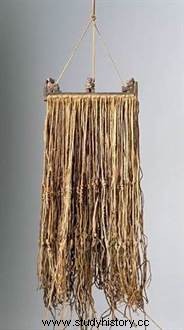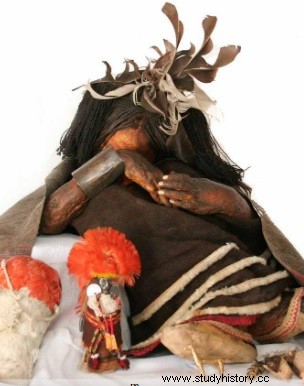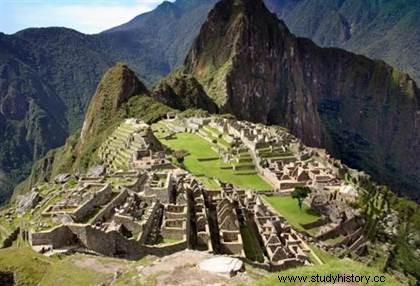 The Inca Empire was founded in the 12th century by the Quechuas, a people from the Cuzco Valley in Peru. It stretched along the Andes for almost 5,000 kilometers from the equator to central Chile and was connected by a network of roads and suspension bridges. In the 15th century, under the action of the sovereign god Vira cocha, it experienced significant growth and was enriched with numerous territories and new peoples. Its peak dates from the beginning of the 16th century. Despite its wealth and power, the Inca Empire only lasted a century before succumbing to the blows of Pizarro and the Spanish conquistadors. The main historical sites of the Incas are Cuzco, the capital, where a famous Temple of the Sun is built, and the fortress city of Machu Picchu.
The Inca Empire was founded in the 12th century by the Quechuas, a people from the Cuzco Valley in Peru. It stretched along the Andes for almost 5,000 kilometers from the equator to central Chile and was connected by a network of roads and suspension bridges. In the 15th century, under the action of the sovereign god Vira cocha, it experienced significant growth and was enriched with numerous territories and new peoples. Its peak dates from the beginning of the 16th century. Despite its wealth and power, the Inca Empire only lasted a century before succumbing to the blows of Pizarro and the Spanish conquistadors. The main historical sites of the Incas are Cuzco, the capital, where a famous Temple of the Sun is built, and the fortress city of Machu Picchu.
The Incas, an Andean people
The Incas were the heirs of cultural traditions dating back to the first communities of fishermen and farmers originating from the plains of the coast of Peru, around 1800 BC. Archaeologists have identified different cultures there, such as that of Chavin (850-200 BC), whose art, characterized by strange animal-gods, is found throughout northern and central Peru. Around 100 BCE, the Mochicas founded what was to become a powerful state on the Peruvian coast. They were ruled by warrior-priests and created marvelous items of gold, semi-precious stone, pottery, as well as beautiful textiles.
 They were conquered around 600 AD by the Huari who overthrew other states, such as of the Nazcas, to build an empire that extended to the heights of the Andes. The presence of the Huari there prevented the Andean Empire of Tiahuanaco from expanding northward. Tiahuanaco was a city near Lake Titicaca, with some 20,000 to 40,000 inhabitants and temples, tombs and beautiful carved stone palaces. Around the year 1000, these two empires broke up into small local states. The most powerful of these states was the Chimú Empire, located in the Moche Valley, which emerged in the early 13th century and eventually extended over 1000 kilometers from the plains bordering the Peruvian coast.
They were conquered around 600 AD by the Huari who overthrew other states, such as of the Nazcas, to build an empire that extended to the heights of the Andes. The presence of the Huari there prevented the Andean Empire of Tiahuanaco from expanding northward. Tiahuanaco was a city near Lake Titicaca, with some 20,000 to 40,000 inhabitants and temples, tombs and beautiful carved stone palaces. Around the year 1000, these two empires broke up into small local states. The most powerful of these states was the Chimú Empire, located in the Moche Valley, which emerged in the early 13th century and eventually extended over 1000 kilometers from the plains bordering the Peruvian coast.
Little is known about the ancient history of the Incas. In all likelihood, they would come from a warrior tribe that resided in the plateau region, south of the Central Cordillera of Peru. According to legend, Manco Cápac led them out of the caves they inhabited in the mountains to make them settle in Cuzco, in a fertile valley of the Andes mountain range. No one knows if Manco Cápac really existed; if so, he lived around 1200, when the Chimú state was formed. For more than two centuries, the influence of the Inca tribe barely exceeded a few tens of kilometers around its capital.
The expansion really begins at the beginning of the 15th century, at the end of the reign of the eighth Inca emperor, Viracocha inca. During the reigns of Pachacutec Yupanqui (1438-1471) and his son Tupac Yupanqui (1471-1493), two skilled warriors, the Incas began to subjugate the surrounding tribes. Symbol of this success, the capital Cuzco is covered with sumptuous palaces and temples. During the reign of Tupac Yupanqui, the Empire had reached its natural limits, although Huayna Cápac (1493-1525) still made some minor conquests.
The Inca civilization
Inca society was extremely hierarchical. The emperor (the Inca) claimed descent from the god of the Sun, Inti, and enjoyed undisputed powers. The Incas believed that their capital, Cuzco, was the center of the Earth. Below the Inca were the governors of the "Four Directions", the main divisions of the Empire, then several other castes of officials who descended to the rank of "foreman", each official being responsible for the supervision of ten families The arable land was divided into three parts:a first part intended to provide for the needs of the State, a second, for those of the priests and a third, for those of the people.
All the Incas, both men and women, paid “taxes” in the sense that they worked on the lands owned by the state and the gods.

 Healthy men also had to work in “detachments” called mit'a. They could be required to build roads or fortresses, to terrace steep mountainsides for new fields, or to build irrigation canals. This system allowed the Incas to maintain a large army full-time in the fields, for long periods of time, which gave them a superiority over their opponents.
Healthy men also had to work in “detachments” called mit'a. They could be required to build roads or fortresses, to terrace steep mountainsides for new fields, or to build irrigation canals. This system allowed the Incas to maintain a large army full-time in the fields, for long periods of time, which gave them a superiority over their opponents.
Women were required to perform crafts such as weaving - fine textiles were highly prized and considered to be more valuable than gold. Taxation was administered without the help of writing. Accounts were kept by means of a “quipu”, an elaborate system of knotted cords. Ropes of different colors represent different kinds of goods, while the number of knots on each rope indicated the amount of food possessed or distributed.
Economy and religion
The Inca economy was based on the intensive cultivation of potatoes and corn, which could not grow either in the east in the Amazon rainforest, which was tropical and therefore humid, nor in the southernmost part of the Andes, which is very arid. The Incas nevertheless practiced the breeding of llamas used as beasts of burden, while the alpaca was domesticated for the quality of its wool.
The road network of the Incas covering 20,000 kilometers allowed years and messengers to quickly travel to all regions of the Empire. The Incas not knowing the wheel, the transport of goods is carried out on the back of llama or alpaca. The conquered peoples were forced to adopt their way of life and their language, Quechua, a language still very widespread in the Andes.
The Inca religion was based on the cult of the god of the Sun, Inti, of whom the emperors claimed to be descendants. His temple in Cuzco was completely covered in gold, the symbol of the sun. Viracocha, the supreme Inca god is worshiped as the creator of all living things. The other divinities which are the object of worship are the gods of the Stars and Time, and the goddesses of the Moon, the Harvests and the Sea. agriculture and the development of seasonal cycles. During the most important ceremonies, sacrificial victims, most often animals, but also men, are offered to the gods.
Human sacrifices among the Incas
 The Spaniards claimed that the Incas sacrificed children they chose among the most beautiful. They took girls and boys from their native villages to Cuzco where they were ritually “married” to the Inca to guarantee health and fertility to the people. They were then taken to the top of a sacred mountain, drunk with alcohol and then buried alive.
The Spaniards claimed that the Incas sacrificed children they chose among the most beautiful. They took girls and boys from their native villages to Cuzco where they were ritually “married” to the Inca to guarantee health and fertility to the people. They were then taken to the top of a sacred mountain, drunk with alcohol and then buried alive.
Until the discovery in 1994 of the mummy of an eight-year-old girl on a mountain in Chile, these stories were thought to be anti-human propaganda. inca intended to justify the annihilation of the inca religion. The girl's body was found at 6,000 meters above sea level, preserved by the dry climate. Her hair was tied in a long braid attached to her belt by a thread of black alpaca wool, and she wore a featherless hairstyle. Leather slippers protected his feet. Her shawl was fastened with silver pins from which hung a miniature box and two gourds.
The buried bodies of two other children were later found on the same mountain. They may have been sacrificed together. Although we do not know the true meaning of these sacrificial burials, they may represent the symbolic relationship between the Inca and the Earth, life and death.
The Fall of the Inca Empire
After the death of Huayna Capac, a bloody war of succession broke out between his sons, Atahualpa and Huascar. Atahualpa finally defeated his brother in 1532, and ascended the throne of a greatly weakened and divided empire. The conquistador Francisco Pizarro then landed on the Peruvian coast. He will take advantage of the same circumstances that allowed Cortés to annihilate the Aztec empire:the internal divisions within the aristocracy, the beliefs that made white men the equals of the gods, as well as Spanish military superiority (armor and firearms).
 Although having only 180 men, Pizarro captured Atahualpa on November 16, 1532 during a meeting between the small Spanish expedition and the Inca delegation. Pizarro's act of incredible audacity paralyzed the Inca Empire, unable to organize an effective resistance in a disproportionate and badly pacified empire. The conquistador eventually had Atahualpa executed, and in 1536 Cuzco fell to the Spanish.
Although having only 180 men, Pizarro captured Atahualpa on November 16, 1532 during a meeting between the small Spanish expedition and the Inca delegation. Pizarro's act of incredible audacity paralyzed the Inca Empire, unable to organize an effective resistance in a disproportionate and badly pacified empire. The conquistador eventually had Atahualpa executed, and in 1536 Cuzco fell to the Spanish.
Resistance was maintained for a few years in the mountains around a new Inca, Manco Capac II, but was reduced by military setbacks and smallpox and other imported diseases by the Spaniards who wreaked havoc among the population. The last son of the sun, Túpac Amaru, was beheaded by the Spaniards in 1572. The Spaniards plundered and destroyed the Inca temples, while imposing Christianity.
Today, Inca customs still exist among the Andean peoples, and the Inca gods have kept their place in Christian rituals. Among the remarkable architectural remains left by the Incas are the city of Cuzco, the fortress of Sacsayhuamán and the famous Machu Picchu, rediscovered in 1911 by an American archaeologist.
Perched at an altitude of more than 2,000 m in the Peruvian Andes, the fortress city of Machu Picchu (13 km2 in area) offers, in addition to a magnificent panorama over the valleys and the surrounding ridges, an exceptional testimony to the Inca civilization.
To go further
- The Incas, by César Itier and Jean-Noël Robert. The beautiful letters, 2008.
- The Incas, by Franck Garcia. Ellipses, 2019.
- Aztecs and Incas:Rise and Fall of Two Fabulous Empires, by William-H Prescott. Pygmalion, 2007.
